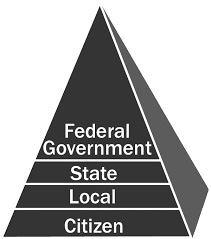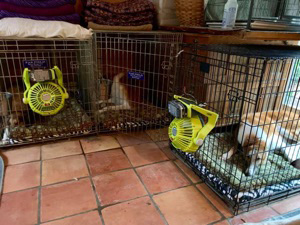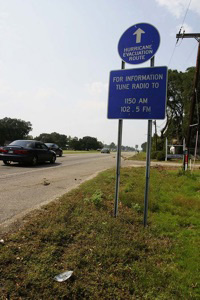
![[ Random Borzoi Image ]](../bannerpicsrandom/image-60.jpg)

![[ Random Borzoi Image ]](../bannerpicsrandom/image-60.jpg)

Image of the Rim Fire in the Stanislaus National Forest by U.S. Forest Service.

Preparedness can reduce vulnerability to disaster, mitigate the impacts of a disaster, or respond more efficiently. The Federal Emergency Management Agency (FEMA) has set out a basic four-stage vision of preparedness flowing from mitigation to preparedness to response to recovery and back to mitigation in a circular planning process. FEMA breaks down preparedness into a pyramid, with citizens on the foundational bottom, on top of which rests local government, state government and federal government in that order.
Only 19% of American families are prepared for a disaster. There are many resources available for disaster planning. The Department of Homeland Security's Ready.gov page

Disasters take a variety of forms to include earthquakes, tsunamis or regular structure fires. That a disaster or emergency is not large scale in terms of population or acreage impacted or duration does not make it any less of a disaster for the people or area impacted and much can be learned about preparedness from so-called small disasters. The Red Cross states that it responds to nearly 70,000 disasters a year, the most common of which is a single family fire.
Preparedness starts with an individual's everyday life and involves items and training that would be useful in an emergency. What is useful in an emergency is often also useful in everyday life. From personal preparedness, preparedness continues on a continuum through family preparedness, community preparedness and then business, non-profit and governmental preparedness. Some organizations blend these various levels. For example, the International Red Cross and Red Crescent Movement has a webpage on disaster training.
The basic theme behind preparedness is to be ready for an emergency and there are a number of different variations of being ready based on an assessment of what sort of threats exist. Nonetheless, there is basic guidance for preparedness that is common despite an area's specific dangers. FEMA recommends that everyone have a three-day survival kit for their household. CDC's recommendations include:
One group of people who put a lot of effort in disaster preparations is called Doomsday Preppers. This subset of preparedness-minded people often share a belief that the FEMA or Red Cross emergency preparation suggestions and training are not extensive enough. Sometimes called survivalists, Doomsday Preppers believe that "The Future Belongs to those who Prepare." "Rule Number 1: Food, you still don't have enough" and "Rule Number 26: People who thought the Government would save them, found out that it didn't."

Emergency preparedness goes beyond immediate family members. For many people, PETS are an integral part of their families and emergency preparation advice includes them as well. It is not unknown for pet owners to die while trying to rescue their pets from a fire or from drowning. CDC's Disaster Supply Checklist for Pets includes:
Given the explosive danger posed by natural gas leaks, Ready.gov states unequivocally that "It is vital that all household members know how to shut off natural gas" and that property owners must ensure they have any special tools needed for their particular gas hookups. Ready.gov also notes that "It is wise to teach all responsible household members where and how to shut off the electricity," cautioning that individual circuits should be shut off before the main circuit. Ready.gov further states that "It is vital that all household members learn how to shut off the water at the main house valve" and cautions that the possibility that rusty valves might require replacement.

In a shelter-in-place scenario, a family would be prepared to fend for themselves in their home for many days without any form of outside support. In an evacuation, a family leaves the area by automobile or other mode of transportation, taking with them the maximum amount of supplies they can carry, possibly including a tent for shelter. If mechanical transportation is not available, evacuation on foot would ideally include carrying at least three days of supplies and rain-tight bedding, a tarpaulin and a bedroll of blankets.